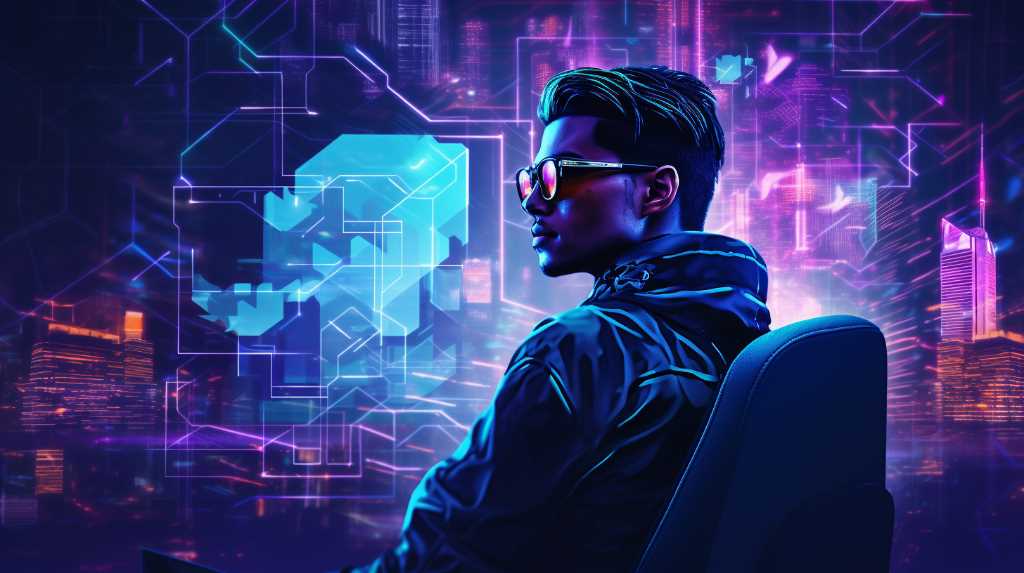I am amazed at how AI security is transforming the technology industry. It acts as a protective shield, safeguarding our data and efficiently stopping cyber threats.
Biometric authentication powered by AI? It’s mind-blowing.
And let’s not forget about automated security operations, making our lives so much easier.
The future of AI security in tech is bright, and I can’t wait to dive deeper into this game-changing technology.

Get ready to master the unbelievable!
Key Takeaways
- AI significantly improves data protection and cyber threat detection through advanced algorithms and real-time analysis.
- AI-powered biometric authentication enhances security measures by analyzing unique physical and behavioral characteristics.
- AI automates security operations by analyzing vast amounts of data in real-time and proactively identifying and mitigating potential risks.
- The future of AI security holds immense promise in revolutionizing technology, including the use of AI-powered drones and facial recognition technology for enhanced protection.
Enhancing Data Protection With AI
In my experience, AI has significantly improved data protection through its advanced algorithms and real-time threat detection capabilities. When it comes to improving network security and safeguarding personal information, AI has proven to be a game-changer.
With its ability to analyze vast amounts of data at lightning speed, AI can identify potential vulnerabilities in a network and proactively defend against cyber threats. By continuously monitoring network traffic and analyzing patterns, AI can detect suspicious activities and flag them for further investigation. This proactive approach allows organizations to stay one step ahead of hackers and protect sensitive data from being compromised.
Furthermore, AI can automatically respond to threats in real-time, mitigating potential damage before it even occurs. Thanks to AI, data protection has reached new heights, ensuring the safety and security of personal information.

As we delve into the next section about detecting and preventing cyber threats, we’ll explore how AI further enhances cybersecurity measures.
Detecting and Preventing Cyber Threats
With its advanced algorithms and real-time threat detection capabilities, AI revolutionizes the way cyber threats are detected and prevented. AI technology has significantly improved network security by enhancing threat intelligence. By analyzing vast amounts of data, AI systems can identify patterns and anomalies that indicate the presence of a cyber threat. This allows for early detection and proactive measures to be taken to prevent potential attacks.
AI can also continuously learn and adapt to new threats, ensuring that network security remains up-to-date and effective. Moreover, AI-powered tools can automate the process of identifying and mitigating threats, reducing the burden on cybersecurity teams.
AI-Powered Biometric Authentication
AI technology continues to revolutionize the world of tech by introducing AI-powered biometric authentication, a game-changing solution for enhancing security measures. This innovative approach to authentication offers several key advantages:

- Enhancing user privacy: AI-powered biometric authentication systems utilize advanced algorithms to analyze unique physical and behavioral characteristics, such as fingerprints, facial features, or voice patterns. These systems don’t store actual biometric data but instead generate a unique template, ensuring the privacy and security of user information.
- Improving accuracy of authentication: Traditional authentication methods like passwords or PINs can be easily compromised. AI-powered biometric authentication provides a higher level of security by leveraging machine learning algorithms to identify and verify individuals based on their biometric traits. This significantly reduces the risk of unauthorized access and ensures accurate identification.
- Seamless user experience: AI-powered biometric authentication offers a convenient and seamless user experience. By eliminating the need for passwords or PINs, users can effortlessly authenticate themselves by simply using their biometric traits. This not only saves time but also eliminates the frustration of remembering complex passwords.
Automating Security Operations With AI
As a security professional, I’ve witnessed the transformative power of AI in automating security operations.
One of the most significant advancements in this field is the ability to automate incident response. AI-powered systems can analyze vast amounts of data in real-time, identify potential threats, and respond with lightning speed. This automation not only saves precious time and resources but also enhances the overall effectiveness of security operations.
Additionally, AI-powered threat intelligence has revolutionized the way we detect and respond to cyber threats. By continuously analyzing and updating threat intelligence, AI systems can proactively identify and mitigate potential risks, protecting organizations from evolving threats.
The future of AI security in tech holds even more promise, with advancements in machine learning and predictive analytics expected to further enhance automated security operations.

The Future of AI Security in Tech
In my experience as a security professional, I’ve been astounded by the unprecedented potential of AI security in revolutionizing the world of technology. The future of AI security holds immense promise, with advancements that won’t only enhance our digital defenses but also impact our privacy in profound ways.
Here are three key developments to look forward to:
- Enhanced threat detection: AI algorithms can analyze vast amounts of data in real-time, enabling the identification of complex patterns and anomalies that humans would miss. This will significantly improve our ability to detect and respond to cyber threats swiftly and effectively.
- Privacy-preserving AI: As AI becomes more prevalent in our lives, privacy concerns are paramount. The future of AI security lies in developing techniques that allow AI systems to analyze sensitive data without compromising privacy. Techniques like federated learning and homomorphic encryption will ensure that personal information remains secure while still enabling valuable insights to be extracted.
- Adaptive defense mechanisms: AI-powered security systems will possess the ability to continuously learn and adapt to evolving threats in real-time. By leveraging machine learning and predictive analytics, these systems will be able to proactively identify and mitigate potential vulnerabilities, making our digital ecosystems more resilient.
These AI security advancements will undoubtedly shape the future of technology, providing us with stronger defenses while simultaneously safeguarding our privacy.
Frequently Asked Questions
How Does AI Enhance Data Protection and What Are the Specific Techniques Used?
AI enhances data protection by utilizing advanced techniques such as machine learning and AI-powered encryption methods. These techniques enable the identification of potential threats, real-time monitoring, and the ability to quickly respond to security breaches, providing a robust defense against cyberattacks.

What Are Some Examples of Cyber Threats That Can Be Detected and Prevented Using Ai?
Using AI powered threat intelligence and AI based anomaly detection, cyber threats like malware, phishing attacks, and ransomware can be detected and prevented. It’s incredible how AI is revolutionizing tech security.
How Does Ai-Powered Biometric Authentication Work and What Are Its Advantages Over Traditional Authentication Methods?
AI-powered biometric authentication uses advanced algorithms to analyze unique physical and behavioral traits for secure access. Its advantages include increased accuracy, reduced fraud, and improved user experience, making it a superior choice over traditional authentication methods.
Can You Provide Some Real-World Examples of Security Operations That Can Be Automated Using Ai?
Sure! Automating security operations using AI has numerous advantages, such as quick threat detection and efficient incident response. However, challenges like data privacy and algorithm biases need to be addressed for effective implementation.
What Are the Potential Future Advancements in AI Security and How Will They Impact the Tech Industry?
Future applications of AI security hold great potential for advancements in the tech industry. However, they also bring challenges and risks. It is crucial to address issues such as data privacy and algorithm bias to ensure the responsible and ethical implementation of AI security technologies.

Conclusion
Well, who’d have thought that artificial intelligence could revolutionize the world of tech security? With its ability to enhance data protection, detect and prevent cyber threats, and automate security operations, AI is paving the way for a safer digital landscape.
It’s almost ironic how a technology that was once seen as a potential threat to our privacy is now our best defense against cyber attacks.
As we look to the future, AI will continue to play a pivotal role in keeping our data secure and our tech world protected.











